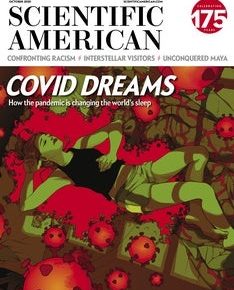Today an e-mail chain I’m on, where contributors swap wacky physics theories, veered into wacky political theories. Chinese communists, one physicist insisted, are orchestrating protests that have been roiling U.S. cities. China wants to make Donald Trump look bad so he loses the fall election to Joe Biden, who is a Chinese puppet. Others on the chain denounced and cheered this conspiracy theory.
Seeking relief from the madness, I shut my laptop and opened The Structure and Interpretation of Quantum Mechanics, by philosopher R.I.G. Hughes, a 1989 book recommended to me by science writer Jim Holt. Hughes attempts to show that the mathematics of quantum mechanics, which can seem terribly arbitrary and ad hoc, has sensible underpinnings. Although Hughes’s treatise baffles me, especially when it devolves into strings of arcane symbols, it still cheers me up.
I’ve been retreating into quantum esoterica a lot lately. Last spring, after COVID-19 ruined my summer plans, I decided to pursue a long-standing fantasy: learning, or trying to learn, quantum mechanics, math and all. The project, which at the risk of grandiosity I call My Quantum Experiment, has served as a refuge for me this summer.
Occasionally, I worry that it’s irresponsible to dwell on quantum puzzles while the world is spiraling out of control. Shouldn’t I devote myself to researching and writing about COVID-19 and other problems plaguing us? Inequality and poverty, racism, sexism, militarism, climate change and so on? The problem is, my columns on these issues have zero effect, which leaves me feeling frustrated and depressed. To counter those emotions, I binge on Netflix—I just discovered the meta comedy series Community—and on quantum mechanics.
Some physicists and philosophers, especially those seeking bestseller-hood, claim that quantum mechanics, if you squint at it from the right angle, can be spiritually consoling. Here are three supposedly comforting quantum implications:
- The crucial role of observation, or measurement, in quantum mechanics implies that reality requires consciousness. Our existence matters, we were meant to be here. As John Wheeler said, this is a “participatory” universe.
- The uncertainty principle and quantum randomness demolish determinism, the idea that we are all bound by unbreakable chains of causes and effects. Far from being locked into a preordained trajectory, nature is creative, open-ended, giving us ample room for free will.
- What physicist Eugene Wigner called the “unreasonable effectiveness of mathematics” suggests that a deity with a fondness for math created the world. When we untangle the twisted geometries at the core of things, we discover the mind of this Geek God.
Do I believe these propositions? Sure, sometimes, on good days. I have a weakness for sentimental metaphysics. And even disregarding quantum mechanics, it’s easy to concoct reasons to believe that God and free will exist, and that we matter.
But the comfort I derive from quantum mechanics stems not from its feel-good implications but from its obscurity, even opacity. I enjoy being immersed in abstractions of abstractions, the meanings of which elude me. As I struggle to grasp eigenvectors or Hermitian operators, the real world and its troubles fade into insignificance. And every now and then I think I’m getting somewhere, which gives me a fleeting thrill.
That happened recently as I muddled through Hughes’s argument that Hilbert spaces are peculiarly suited to representing quantum things. Hilbert spaces aren’t spaces in the ordinary sense with width, length and depth, like your bedroom or the sky. They are habitats for vectors, which you can think of as arrows of a specific length pointing in a specific direction. Vectors can describe anything, from human faces to quarks.
Let’s say you represent the state of an electron with a vector, V, in a Hilbert space with three axes, x, y and z. (Remember, these aren’t the dimensions we live in.) Then V equals the sum of three shorter, orthogonal vectors along the x, y and z axes. Call these vectors VX, VY and VZ. According to the rules of vector arithmetic, V = VX + VY + VZ.
I’m getting this, but not really, when Hughes says the Pythagorean theorem is the key to understanding Hilbert spaces. As always with quantum math, there’s a twist. Instead of the Pythagorean theorem I’m familiar with, Hughes presents one for three dimensions. “Pythagoras’ theorem tells us,” Hughes writes, that |Vx|2 + |Vy|2 + |Vz|2 = V2. Really? The Pythagorean theorem works in 3-D? I never knew that.
Also, those vertical lines mean you’re taking the absolute value of each vector. Why? Shouldn’t squaring the vectors make them positive? Ordinarily, but quantum vectors are often expressed as complex numbers, which contain imaginary numbers, based on the square root of negative one. That’s why you need those vertical lines. Why imaginary numbers? Because they work, is the short answer. I hope to know the real answer someday.
Anyway, these squared vector values, |Vx|2, |Vy|2 and |Vz|2, represent the probabilities that the electron will be in a particular state when you measure it. It must be in some state, so all these fractional probabilities must add up to one. That is also the value of V, which can be thought of as the hypotenuse, and hence of V2. So |Vx|2 + |Vy|2 + |Vz|2 = V2 = 1. Getting the probabilities to equal one is called normalization.
Now everything is starting to make sense. All these seemingly arbitrary mathematical rules are based on the Pythagorean theorem plus probability theory. I’m reminded of a lecture in which computer scientist Scott Aaronson calls quantum mechanics just a “generalization of probability theory.” Many physicists fail to appreciate this fact, Aaronson says, because they have been poorly taught. Courses on quantum mechanics usually retrace its historical development, during which physicists devised “a complicated patchwork of ideas” to account for experimental anomalies like the blackbody paradox. Aaronson continues:
“Today, in the quantum information age, the fact that all the physicists had to learn quantum this way seems increasingly humorous. For example, I’ve had experts in quantum field theory—people who’ve spent years calculating path integrals of mind-boggling complexity—ask me to explain the Bell inequality to them. That’s like Andrew Wiles asking me to explain the Pythagorean Theorem.” (Emphasis in original.)
Andrew Wiles is the mathematician who proved Fermat’s last theorem in the 1990s, and the Bell inequality is a mathematical proof related to a quantum paradox called nonlocality. Hughes’s riff, and Aaronson’s, suggest that quantum mechanics, in spite of its daunting reputation, is conceptually simple, as simple as the Pythagorean theorem, which I learned in my childhood.
These epiphanies never last. As I keep reading, I lapse back into befuddlement, or, at best, a dim quasicomprehension that eggs me on. Moreover, reality keeps intruding on my quantum reveries. That happened recently when, eager for fresh air, I stuffed a quantum textbook, a notebook and a collapsible chair in my backpack, pulled on a face mask and left my 11th floor apartment.
The elevator stopped a few floors below mine, and a young man in a muscle shirt stepped on, wearing no mask. I said, You can’t get on without a mask. Glaring at me, he pulled a mask from his pocket and pulled it over his face, saying, Happy? Before he stepped on the elevator, this guy was in a superposition of states. But as soon as we interacted, his wave function collapsed into jerkitude.
My blood was still boiling when I arrived at a park near my building, a grassy pier that juts into the Hudson River. I found a shady spot between several chattering young families and assembled my collapsible chair. Soon I was struggling so mightily to comprehend wave functions that I forgot about the jerk on the elevator and the conspiracy theorists on my physics list.
I occasionally looked up from my book to glance at the Hudson, its surface crisscrossed by waves, and at the exuberant moms, dads and kids around me. It was the kind of sunny, sparkly day that makes it hard to imagine all the misery out there, all the anger and fear.
I thought: What if you could construct a wave function for the United States? What would it show? We would be suspended in a superposition of many states, from okay to very, very bad. This fall, the presidential election will serve as a test, a measurement, that collapses the wave function of America and reveals who we really are. Then more than ever, I may need to retreat into My Quantum Experiment.
Richard Feynman warned against trying to understand quantum mechanics: “Do not keep saying to yourself, ‘But how can it be like that?’ because you will get ‘down the drain,’ into a blind alley from which no one has escaped. Nobody knows how it can be like that.” Hughes and other sages reject Feynman’s stance as defeatist. I find it heartening. I like the thought of slipping down the drain of a bottomless mystery as the world collapses over and over again around me.
Postscript: Thanks to physicist Sabine Hossenfelder and philosopher of physics David Albert for fact-checking this column. Hossenfelder, who rejects free will, says quantum mechanics “makes room for fundamental randomness,” but “there is no ‘will’ in this.” Albert said “it might puzzle the reader that you talk (perfectly correctly) about the ‘lengths’ of the vectorial inhabitants of Hilbert spaces just after having said that ‘Hilbert spaces aren’t spaces in the ordinary sense with width, length and depth, like your bedroom or the sky.’ Maybe it would help to replace ‘width, length, depth’ with something like ‘up-down, right-left, backwards-forwards’?” Otherwise, Albert and Hossenfelder okayed the piece, so please blame them for errors.
Further Reading:
String Theory Does Not Win a Nobel, and I Win a Bet
Making Sense of Quantum Mechanics
David Bohm, Quantum Mechanics and Enlightenment
See also “Tragedy and Telepathy,” a chapter in my free online book Mind-Body Problems.




